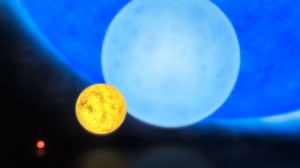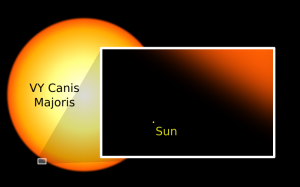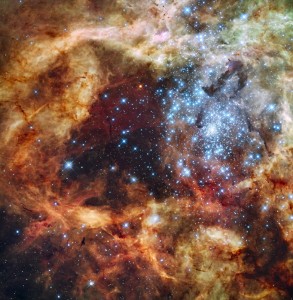EDIT: added in another image of star cluster R136
Ladies and gentlemen, let me introduce you, to Hypergiant “blue” R136a1, “The New” Solar Mass Heavyweight Champ! Weighing in at an estimated 265 solar masses, he may very well be the most massive star in our universe! He’s so big, that scientists are baffled by how he came to be.
You heard it folks, there’s a newly discovered star, that’s so heavy that it disputes current models of how stars may be formed. R136a1 was discovered last year with the findings published in July 2010. It’s found in a star cluster known as R136 that’s 165,000 light-years away.
In 2005 NASA had released an article which suggested that in our current era of the universe, stars cannot exceed 150 solar masses (i.e. 150 times the mass of the sun) otherwise they would violate the Eddington Limit. This limit is where the radiation force outwards of a star is equal to the gradational force pulling inwards. Stars bigger than this would have too much out flowing radiation that they would eject all their gaseous matter into space.
This may be the case for R136a1: scientists speculate it was actually much heavier at its formation and may have lost as much as 50 solar masses through continuous emission of stellar winds in the last million years due to its instability. So, how did R136a1 come to be? Scientists speculate that its ridiculous size may be attributed to several young stars colliding together to form a single object.
One thing to keep in mind is that while R136a1 is the heaviest known star, at only 35 solar radii (i.e. 35 times the radius of the sun), it is certainly not the largest. The title of “biggest star” belongs to VY Canis Majoris that is 1800-2,100 solar radii in size! At the same time, it is only 30 times the mass of our sun.
As for its fate, R136a1 is too big to form a black hole and may instead explode as hypernova (an explosion equivalent to over 100 supernovae). Of course, that’s only if it doesn’t blow all of its matter into space before then..
The original article can be found here (#83, “The Biggest Star of All”): http://discover.coverleaf.com/discovermagazine/201101?pg=76#pg76
NASA’s 2005 article can be found here: http://www.nasa.gov/home/hqnews/2005/mar/HQ_05071_HST_galaxy.html
For more general information on hypergiant stars, see: http://en.wikipedia.org/wiki/Hypergiant









